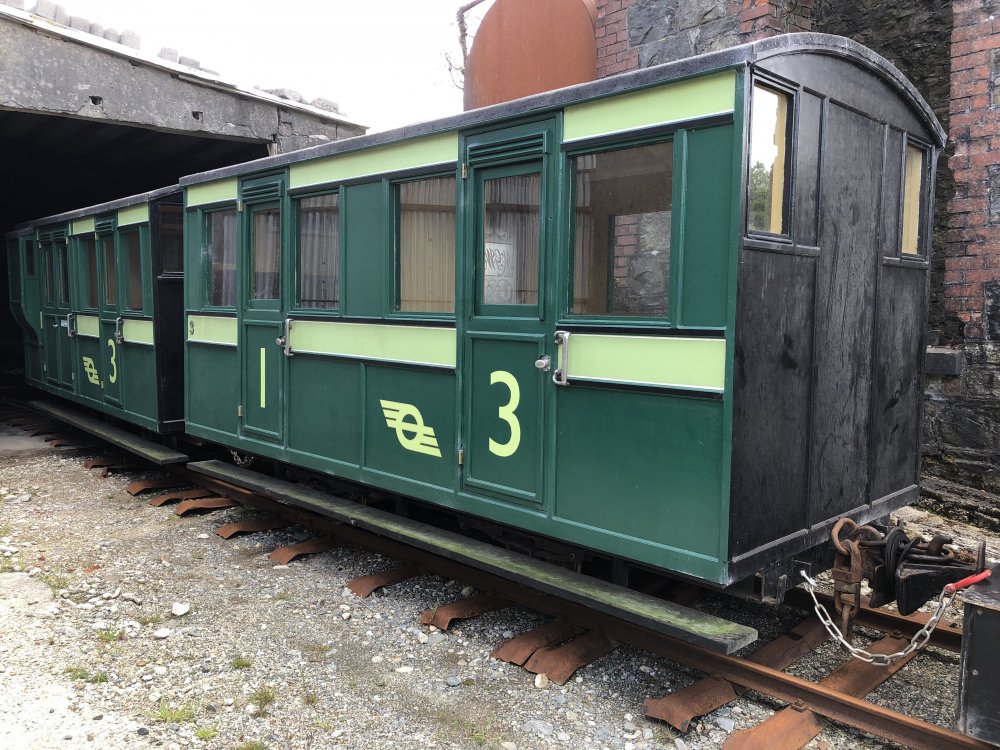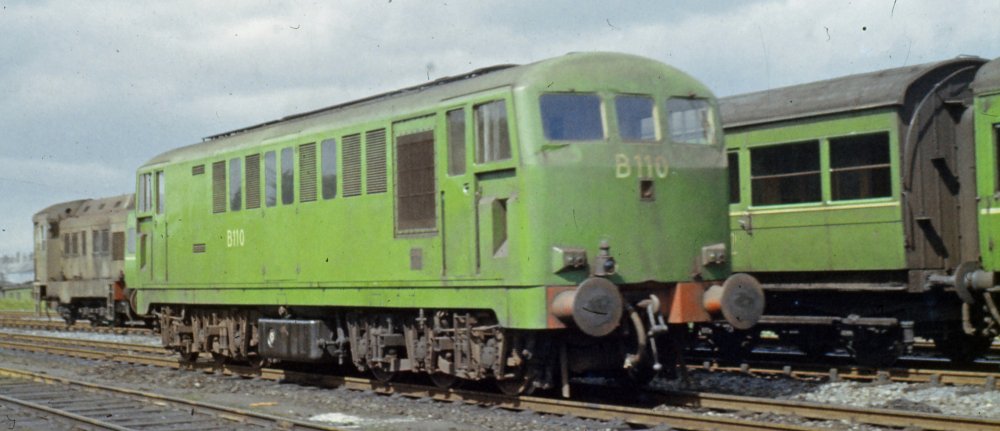-
Posts
15,853 -
Joined
-
Last visited
-
Days Won
393
Content Type
Profiles
Forums
Events
Gallery
Everything posted by jhb171achill
-
New one to me, Warbonnet - I suspect this is like the very first "Woolwich" in MGWR livery, but sprayed GSR grey before even a fire had been lit in her, and that "A" with the yellow band at Inchicore - something which didn't actually see the light of day. As Seagoebox shows above, at first it had "001"; that pic was a photoshoot before it entered traffic. It will also be seen that the very first examples painted into "Supertrain" livery had their numbers on the ends shaded in orange, same way that the ones on the sides were shaded in black. I saw this on at least one 141 too, but the very first 121s I saw (IN 1972) had plain white numerals on the ends.
-
"A"'s were never used in traffic in West Cork, but a trial run was carried out once or twice. The traffic didn't warrant them, nor would it ever have been likely to have done, and in places it's possible bridges or track - which by 1955 was indifferent at best - mightn't have been keen on them. However, had, for example, the Bantry oil terminal required oil trains in the 1960s, and the line survived maybe until the 1975 closures, it's likely you'd have got "A"s on the oil trains and inevitably 141s on passenger.
-
What are the practicalities of putting DCC in that thing?
-
I got mine delivered to a relative in Britain, who accidentally brought it over to me.......
-
Exactly! And I echo your comment about bulk buying. This Sunday I will be meeting up with a few characters who may also be interested in this.
-
Yes, I got one locomotive a while back which resulted in the postman wanting an extra €126!
-
That's the trouble! Worth selling the car for......... And, for a layout based in Wisht Caaark, boy, it's essential, as J15s never ran there!
-
Remember those old pre-Murphy 121s? Anyone got the bits and pieces for the cab and body? No chassis needed. Scrap bits welcome.
-
FOR SALE I am assisting a friend with a house clearance, and among it is a quantity of stuff that the deceased had acquired - I guess in the 1980s - with a view to making a layout. I told the widow I would ask about to see who's interested. There are some 38 yards of unused track, still in a box labelled "W & H Models, London", plus a "Zero One" control system. I suggested to her that she might get €60 for the lot. Thus; it's on offer as such. PM me if interested.
-
Standard open wagons, I think, with tarpaulins.
-
One of Fry's slides is so bad it shows a purple - yes, you heard - "A" class with a lifting train approaching Naas in a cutting, with blue and purple grass on its sides, and browny purple rails and ballast. Since the sky is a mauve colour, I am thinking there may still be operational "A"s on Mars........
-
Drew, an excellent and informative post. As one involved in the displays and the Fry history end of things (not the layout) I appreciate your comments on behalf of the museum. I will pass your comments on to the management tomorrow when I am contact with them over other issues. To comment on some of the points you raise: Why did the castle layout close? Answer - the operators wanted the space for the new Avoca shop and cafe. They were faced with having to make the whole Castle operation viable - and model railway museums cost money rather than generate it. The Avoca shop helps them balance their budget which they are under pressure to do - it's public money they'd be using up otherwise, and Fingal Council quite simply do not have a budget for such things. The Castle layout contained some of the Fry models in glass cases, but the ones operating on the huge layout were not made by Fry - they were made 20 years after his death by some 7 modellers (so far identified); some still with us, others not. Under the term of the 1972 legal agreement between Fry's widow and any future owner of his collection, his models were never again to be run, but displayed in a museum-like scenario. You mention the size of the layout in the casino now. The current architectural plan for this building was drawn up (a) to fit a certain budget, and (b) BEFORE any serious effort was made to seek help or advice from experts in this field; when the project eventually came to the attention of potential layout builders, they pointed out that there would only be room for an 00 gauge layout in that building, as it was far too small for a meaningful 0 gauge layout. I was at the meeting where it was pointed out to the architects, designers and county council officials that there was not a snowball's chance in hell of recreating anything remotely similar to what used to be in the Castle! To top all that, the local authority and architects had a completely unrealistic take on how long the layout would take to build; but that's all water under the bridge now. Your point about signage on each of the four sides of the layout explaining the history is an excellent idea, and it is one which I will take on board. You can expect to see signage to this effect. Thank you for this excellent suggestion. Regarding the display screens at the Malahide side of the layout, you're right about the lack of space there, but it's the best that can be done at the moment. Again, those screens need to be updated, and the written history that shows up for each item in it is on my (LONG!) list of "to-do" things. In the long run I will expand on the descriptions and see if I can persuade them to move one of these screens to another wall; I have an idea where one could go. Again, thank you for the feedback. The stuff in the shop is in its infancy. There will be a change of operational management at the end of the year, and the incoming personages - whoever they may be - will be taking a look at the retail end. Recently, a range of mugs, keyrings and other materials with pictures of a variety of models has been commissioned. A certain amount of railway books may appear in the long run. As for scale models, there are viability issues here, given the small number of items - but I do know that an arrangement with a supplier is currently being explored. Thank you again for your comments - feedback like this is absolutely invaluable. I should also add that all of Fry's Irish models are now on display; in the old place only some were. He also made a number of English and mainland European models. All but (I think) one of the continental items are on display in one case (there were only a few), but the British stuff (mostly LMS & LNWR) remains at present in storage. It is hoped that in the long run a budget may be made available for displaying these in glass cases too. There are about 50 or 60 of them from memory.
-
Now THAT is interesting; first I can recall seeing with a waistline. But note also: the DARK green - I think! I certainly did not think that ANY of those got the dark green. One for IRM Towers' Research Dept. for the RTR B101 released next month! Now THAT is interesting; first I can recall seeing with a waistline. But note also: the DARK green - I think! I certainly did not think that ANY of those got the dark green. One for IRM Towers' Research Dept. for the RTR B101 released next month! AND no red buffer beam..........experimental, I wonder?
-
No, never yellow, nor white - always the light green “eau-de-nil”. Photo reproduction often shows it to look faded or even whitish, but in real life the livery was only for five years and they never got the chance to fade. Silverfox models seem to use a whitish colour on the green, or black numerals on the silver - both are wrong. Some locos in the above livery had this waistline light green band, others didn’t. Same, exactly, as in the 1960s some black locos had yellow panels and others didn’t. And in the 1990s some engines had dayglo panels and others didn’t. But these waistlines, plus “snails”, plus numbers, were always “eau-de-nil” only, on either silver or green locos.
-
Irish Railway Station Posters
jhb171achill replied to Colin R's topic in Photos & Videos of the Prototype
Those type of things crop up on fleabay from time to time; the going rate now seems to be the best part of €300 a throw!
.png.c363cdf5c3fb7955cd92a55eb6dbbae0.png)






